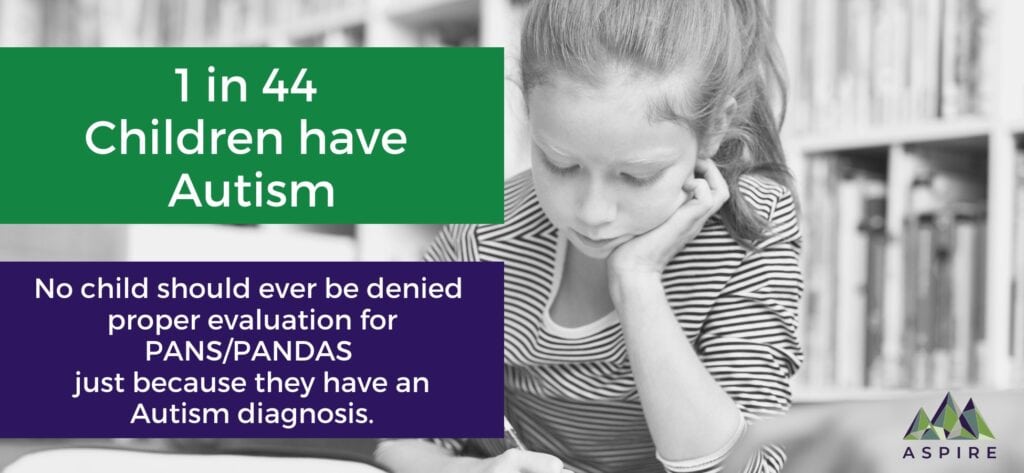CDC’s Autism Numbers
The CDC has released the new estimated Autism Prevalence rates. They report that 1 in 44 or 2.27% of American 8-year-olds have an autism spectrum disorder (ASD) as surveyed in 2018. This was a 23% increase over two years ago when the CDC said the estimated numbers were 1 in 54 in 2016. It is critical to note that today’s numbers of 1 in 44 shows a 241% increase from CDC’s numbers released in 2000 when the rate was 1 in 150.

PANS & Autism
If you are a parent to a child with Autism or suspected Autism, please consider that your child may have PANS PANDAS. They may not have Autism at all but may have PANS PANDAS, or they may have both conditions. ASPIRE’S Professional Advisory Board has published a toolkit, PANS/PANDAS Guidelines for Children with Autism. Please download the toolkit today and share it with your provider and friends and family.
No one should be denied a proper evaluation of PANS PANDAS. Members of the ASPIRE Professional Advisory Board have written PANS/PANDAS Guidelines for Children with Autism because too often, the medical conditions of children with Autism are overlooked and dismissed as “just the autism,” but children with Autism are at risk for the same medical conditions as children without Autism, including PANS PANDAS. This informational packet discusses the unique challenges of diagnosing PANS PANDAS in kids with Autism, what it can look like in the school setting, the PANS diagnostic criteria, and treatment guidelines. Please share this information; let’s work on properly diagnosing and treating children, so we do not consign them to a lifetime of mental health issues.
When to Evaluate Your Child with Autism for PANS
- If a child has sudden regressive Autism, they should be evaluated for PANS/PANDAS.
- If a child has sudden worsening of symptoms associated with Autism, they should be evaluated for PANS/PANDAS.
- If a child with Autism has new behaviors or symptoms that correspond to the PANS/PANDAS diagnostic criteria, they should be evaluated for PANS/PANDAS.
About the CDC’s Numbers
The rate of 1 in 44 was published in Morbidity and Mortality Weekly Report on December 3, 2021. They use the Autism and Developmental Disabilities Monitoring (ADDM) Network to pull numbers from 5,058 8-year-old children with Autism in Arizona, Arkansas, California, Georgia, Maryland, Minnesota, Missouri, New Jersey, Tennessee, Utah, and Wisconsin. California now has the highest rate of Autism, with 3.9% of children in the state affected. Before this current survey, California had not been included in the survey. Historically, the CDC considered New Jersey to have the highest rates, but since California was not included previously, it is hard to tell what the historical change truly is, if any. These numbers reflect prevalence rates; they are comprised of a sampling of states. They are not a full census of the children in the United States.
As per the ADDM, boys outnumber girls by roughly 4 to 1. Specifically, the rate for boys is 3.6%, and for girls, it is .8%. The rate for boys in California is 6.4% which they say must be monitored as it is incredibly high.
Maenner MJ, Shaw KA, Bakian AV, et al. Prevalence and Characteristics of Autism Spectrum Disorder Among Children Aged 8 Years — Autism and Developmental Disabilities Monitoring Network, 11 Sites, United States, 2018. MMWR Surveill Summ 2021;70(No. SS-11):1–16. DOI: http://dx.doi.org/10.15585/mmwr.ss7011a1
Autism Prevalence Rates – Years Reported
- 2021 – 1 in 44 (Survey 2018, Birth Year 2010)
- 2020 – 1 in 54 (Survey 2016, Birth Year 2008)
- 2018 – 1 in 59 (Survey 2014, Birth Year 2006)
- 2014 – 1 in 68 (Survey 2010, Birth Year 2002)
- 2012– 1 in 88 (Survey 2008, Birth Year 2000)
- 2009 – 1 in 110 (Survey 2006, Birth Year 1998)
- 2009 – 1 in 125 (Survey 2004, Birth Year 1996)
- 2007 – 1 in 150 (Survey 2002, Birth Year 1994)
- 1995 – 1 in 1000
- 1970’s – 1 in 10,000
Please note, not all providers are PANS literate, so if you strongly suspect that your child may have PANS PANDAS, please refer to our Provider list.